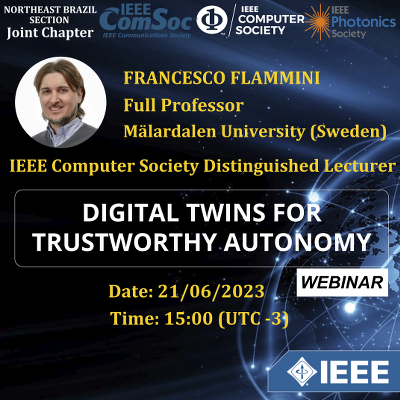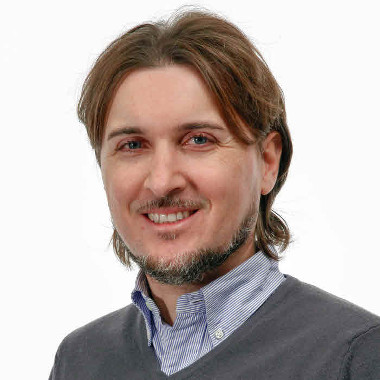Digital Twins for Trustworthy Autonomy

The concept of risk is a combination of threat probabilities, vulnerabilities and expected consequences. In traditional risk modeling and evaluation approaches, analyses are performed at design time and possibly repeated periodically, or at any relevant system change. With such approaches, there is no possibility to evaluate how the risk evolves over time as a condition of actual system state and detected threats. One challenging objective in the field of connected cyber-physical systems (CPS) and the Internet of Things (IoT) is to improve resilience by providing non-trivial mechanisms for run-time threat detection, risk estimation and system reconfiguration following Self-X principles like self-diagnostics and self-healing. Threats include faults, errors and failures, and can be either intentional (e.g., security attacks) or unintentional (e.g., random faults). A central issue is to develop model-based approaches allowing for run-time risk evaluation accounting for uncertainties in system itself and in the surrounding environment. Those models should be such to account for growing complexity (size, distribution, heterogeneity) and criticality of modern CPS. Multi-paradigm modeling can combine probabilistic modelling languages borrowed from Artificial Intelligence (e.g., Bayesian Networks) with formalisms like high-level Petri Nets, in order to find the optimal balance and trade-off between ease of use, expressive power and solving efficiency. Models used in static risk assessment at design time can be reused and integrated in appropriate frameworks to allow online monitoring of relevant system parameters, threat detection and dynamic adaptation to respond to threats. In critical applications, the reuse of suitable models already employed for system certification together with run-time model-checking supports explainable Artificial Intelligence (XAI) that is requested to build trustworthy autonomous CPS like self-driving vehicles. The next generation of run-time risk models will act as Digital Twins to anticipate threats and enable novel paradigms like proactive dependability and collaborative security as a support to prognostics and preventive maintenance in Industry 4.0 and other smart-X applications (e.g., smart-houses, smart-cities, smart-transportation, etc.). In fact, Digital Twins (DT) are emerging as an extremely promising paradigm for run-time modelling and performability prediction of cyber-physical systems (CPS) in various domains. Although several different definitions and industrial applications of DT exist, ranging from purely visual three-dimensional models to predictive maintenance tools, in this talk we focus on data-driven evaluation and prediction of critical dependability attributes such as safety. To that aim, we introduce a conceptual framework based on autonomic systems to host DT run-time models based on a structured and systematic approach. We argue that the convergence between DT and self-adaptation is the key to build smarter, resilient and trustworthy CPS that can self-monitor, self-diagnose and – ultimately – self-heal. The conceptual framework eases dependability assessment, which is essential for the certification of autonomous CPS operating with artificial intelligence and machine learning in critical applications.
Date and Time
Location
Hosts
Registration
-
 Add Event to Calendar
Add Event to Calendar
Loading virtual attendance info...
Speakers
 Francesco Flammini of Mälardalen University (Sweden)
Francesco Flammini of Mälardalen University (Sweden)
Francesco Flammini
Full Professor, Mälardalen University (Sweden), IEEE Computer Society Distinguished Lecturer
Biography:
Francesco Flammini graduated cum laude (M.D., 2003) and got a research doctorate (PhD, 2006), both in Computer Engineering, from the University of Naples Federico II, Italy. He has worked for 15 years in private and public companies, including Ansaldo STS (now Hitachi Rail) and IPZS (Italian State Mint and Polygraphic Institute), on large international projects addressing intelligent transportation, critical infrastructure protection and cybersecurity, as a technical leader and unit head. He is currently a Professor of Trustworthy Autonomous Systems at the University of Applied Sciences and Arts of Southern Switzerland, where he is the head of the Bachelor in Data Science and Artificial Intelligence, and he is affiliated with Dalle Molle Institute for Artificial Intelligence (IDSIA). Since 2020, he has been a Full Professor of Computer Science with a focus on Cyber-Physical Systems at Mälardalen University (Sweden), and the Technical Manager of the RAILS EU funded research project about Artificial Intelligence for smart-railways. Previously, he has been a Senior Lecturer and the chair of the Cyber-Physical Systems (CPS) environment at Linnaeus University (Sweden). He is a Senior Member of the IEEE and a Member-at-Large of the IEEE SMC Board of Governors. He has (co)authored 150+ technical publications, and he has served as a chair, invited speaker, steering/program committee member, and editor for several international conferences and journals.

